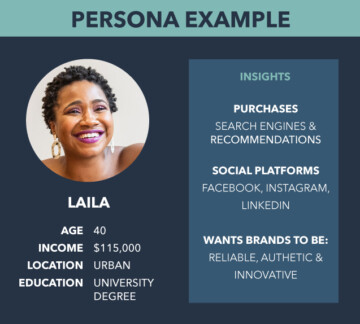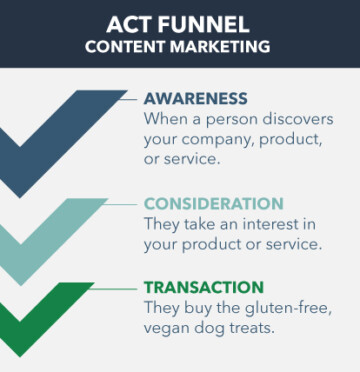Why isn’t your high-end dog boutique selling more gluten-free, vegan dog treats? Odds are, you’re barking at the wrong audience. In order to reach the folks who want gourmet snacks for their dogs, you need to know who they are—this is where buyer personas come in. You’ll also need a content marketing strategy to reach them where they live online.
Settle in and find out what makes a great buyer persona, tips for developing personas for marketing, and how to use them to create better content.
What’s a Persona?
A persona is a focused member of your target audience. Whereas a target audience defines a group of customers, a persona zooms in to look at specific members of that group.
For example, let’s say your luxury dog boutique sells gourmet food, organic treats, crystal-studded collars, and luxe bedding. Your target audience would be dog owners, right? In order to better understand, reach, and learn how to speak to your audience, you need to create personas.
It’s fairly clear that you’re not selling your goods to owners of Australian cattle dogs that herd cows on a farm. They’re not shopping for Gucci-inspired, vegetable-dyed, eco-friendly leather collars with clear Swarovski crystal surrounds.
But, who exactly are you selling to?

Tips On Developing Personas for Content Marketing
When it comes to content marketing strategies, and digital marketing strategies in general, you want to know all the nitty-gritty details about your ideal customers.
Why get so specific? Not only can you sell more products, your personas are far more likely to become brand advocates. Ideally, they’ll help do some of your marketing for you. Advocates will spread the news about your business through word-of-mouth, leave positive reviews, and organically grow your brand’s visibility.
Learning About Your Ideal Customers
There’s so much you can learn when embarking upon persona development. It’s important to gather both quantitative and qualitative data. Drawing insights from both will allow you to turn a two-dimensional audience member into a fully fleshed out three-dimensional persona.
Where should you start? At Mad Fish Digital, we use a variety of research tools, like Global Web Index, as well as social media research and market evaluation, in order to create personas.
Below are buckets of information you’ll want to focus on:
Demographic Data: This is helpful socioeconomic information every marketer wants to know. For example, the ages of your personas, marital status, income, and education.
Behavioral Insight: Find out what “actions” your personas take. This could be their online shopping habits, the social media sites they visit, and what devices they use.
Psychographic and Attitudinal Information: Get insight into the psychological characteristics and traits of your personas. For example, what they want from brands, their values, beliefs, and goals.
The insights you’ll get from your research will be incredibly precise. These are just some of the specific questions that can be answered:
- What motivates your persona’s decision-making (price, quality, customer service, etc.)?
- What goals does the persona have that your product or service could help them meet?
- How do they find out about brands and what’s their online purchase journey?
- How do they feel about social media, what platforms do they use, and what actions do they take on these platforms?
- When are they online and what devices are they using?
These are just some of the hundreds of profile points you can plumb to understand who your personas are, the type of content that they’ll connect with, the best platforms to use in order to share content, and ultimately how to reach them on their buying journey.
3 Tips to Get Your Content Marketing Moving
1) Understand the ACT Funnel
There are three main stages in every prospect’s buyer journey:
- Awareness. When a person discovers your company, product, or service.
- Consideration. They take an interest in your product or service.
- Transaction. They buy the gluten-free, vegan dog treats.
You’ll want to produce content that addresses each stage of the funnel, from promoting brand awareness, to educating the potential customer, to that final call to action.
2) Evaluate Your Existing Content
What’s working? Do you have content that’s performing well and addresses the pain points, questions, and wants and needs of your personas? Go ahead and create additional content around these topics, products, and services.
What’s not working? Are there pages on your website that don’t perform well? They may have a high bounce rate, poor time on page, or not show conversions. This most likely means the content isn’t connecting with your customers and it’s time for a refresh.

What are the gaps in your content? Based on what you now know about your customers, how can you step up your game? For example, if you’ve found out your personas are likely to read newsletters, create one or enhance your current newsletter. Post more content on your site that you can share to increase engagement.
3) Plan Your Tactics
Determine the purposes of your content pieces. Keep in mind, it’s very likely you have more than one persona to work with. This may impact the purpose of your content pieces. In order to best engage your audience, do you want to become a thought leader in your industry and a go-to resource? Should you increase your focus on driving brand affinity?
Decide what deliverables you should create. What content pieces will they find most valuable? Case studies and white papers are great thought-leadership pieces. Refreshing a web page, or creating a new one, about your workplace EDI (Equality, Diversity and Inclusion) would be one way to build brand affinity.
Choose your distribution methods. You have all you need to know where your personas live online, from the social networks they use to what type of content they’re searching for. Therefore it’s a breeze to figure out where to share your content.
Moving forward, your content strategy and persona insights will serve as the go-to resource for the planning and execution of ongoing content. Plus, it will help you identify areas of opportunity and create cohesive content plans that will help you reach and exceed your KPIs.
Learn About Our Customized Content Marketing Services
In need of a content marketing strategy or looking to improve your current approach? Mad Fish cares about your brand—we take a thoughtful, solutions-oriented approach to telling brand stories. We’d love to chat with you about how our customized, results-oriented strategies can deliver your message, engage your customers, and reach new audiences.
Contact us with questions about our content and other digital marketing services. We’re ready when you are!

